 |
| bicycles: Linus, outfits: Chrome, models: unknown |
Now in its 4th year, the Interbike City Style Fashion Show, presented by Momentum Magazine, was a production in true Las Vegas style. The models - all real bicyclists with healthy body mass indices and mischievous grins - didn't just cycle down the runway. They pranced, twirled, froze in fetching tableaux, and performed choreographed little dance numbers worthy of a small scale musical - against an ever-changing backdrop representing North American cities.
 |
| model: Susi Wunsch of VeloJoy, dress: Nona Varnado, bicycle: unknown |
Each model would begin with the standard runway walk, then, seemingly spontaneously strike an outrageous pose or break out into a full on dance routine. Could this have been inspired by
Glee?
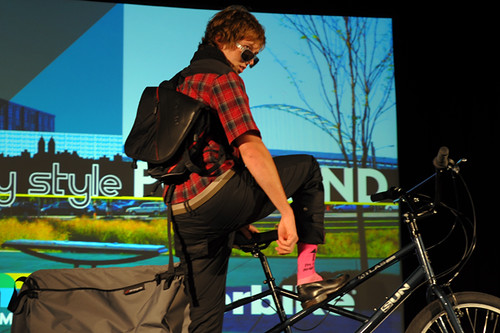 |
| bicycle: Sun Atlas, outfit and model: unknown |
Whatever the inspiration, it was a great display of showmanship, keeping the audience entertained and energized.
 |
| bicycle: Bella Ciao Superba; panniers: Basil, outfit and model: unknown |
After doing their thing on the stage, the models would ride down a ramp and proceed along a cycle path marked with sharrow decals that wound through the spectators' area, adding an interactive element to the show and creating multiple focal points.
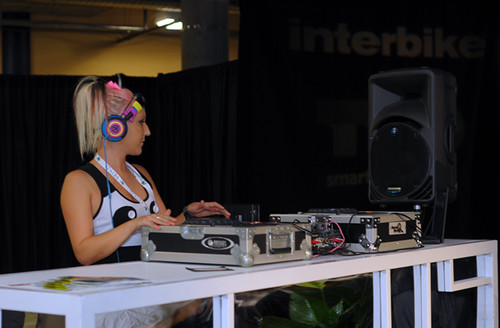
The DJ did an excellent job keeping the energy levels high, and even while taking photos I found myself moving and snapping to the beat.
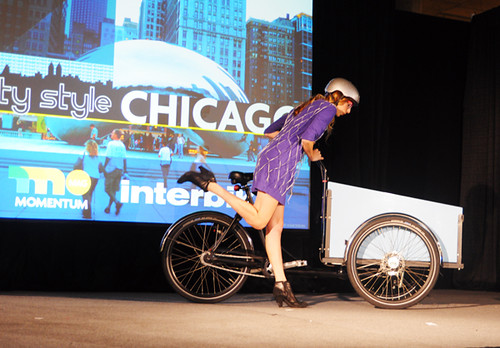 |
| bicycle: Christiania cargo trike; model and outfit: unknown |
It was all great theater, though on a critical note I am not sure how well it worked as a fashion show per se.
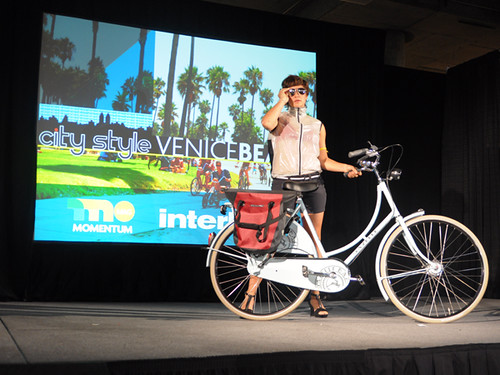 |
| bicycle: Gazelle Basic, model and outfit: unknown |
I found it surprising that the designers were not named and the pieces worn by the models were not vividly described. If the point of the fashion show was to exhibit new lines of cycling-specific apparel and introduce the audience to new designers, I did not really feel that happening. It's possible there was a brochure I missed where this information was provided [
edited to add: yup, there was - someone's just emailed me a copy and I've posted it here], but even then I feel that it should have been a prominently vocalised part of the show itself.
 |
| bicycle: Biomega, dress: Sheila Moon, model: unknown |
This neo-Edwardian dress - which is difficult to photograph but looks stunning in person - was my favourite piece, but unfortunately I did not know who made it or anything else about it at the time of the show. I've since been told it's by
Sheila Moon, but I do not see it on her website - link to the dress anyone? I have a dozen photos of it, but as luck would have it most of them came out blurry!
 |
| bicycle: Handsome Cycles, trench: Madame de Pe |
Another piece that stood out was this cape-like trenchcoat, with its unusual tailoring. I imagine the tent-like shape is to keep the knees dry in the rain.
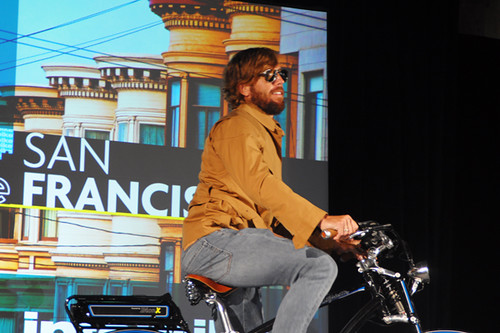 |
| model: Will of BoxCycles, bicycle: Styriette Pedelec, outfit: unknown |
In general, I would have loved to learn more about the clothing, and to know what exactly makes each outfit conducive to cycling - especially since some of the designers must have worked hard on that aspect.
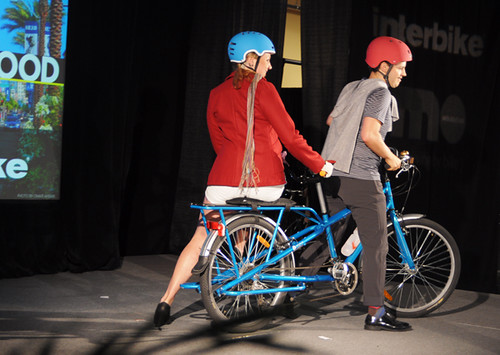 |
| bicycle: Yuba, outfits and models: unknown |
All in all, I think the show was more about fostering a positive, even romantic image of the bicycling lifestyle than about displaying specific pieces of apparel - which I don't have a problem with in the least, but which I don't believe is technically a fashion show. Then again, who wants to be technical about it if the audience is having a good time.
 |
| bicycle: Electra, outfit and model: unknown |
One concept that the show brought across quite successfully, I thought, was the possibility for variety. Some pieces did seem to be bicycle-specific designs, while others appeared to be just regular clothing. Some models were wearing helmets and others were not.
It seems that many manufacturers are trying their hand at cycling-specific street apparel nowadays: everything from jeans and dressy trousers to button down shirts and blazers. And while some believe that to ride for transportation one need only look in their closet, others welcome these bicycle-specific inventions. The Interbike Fashion Show seemed to embrace both views - encouraging cyclists to wear whatever makes them comfortable and to have fun with it.
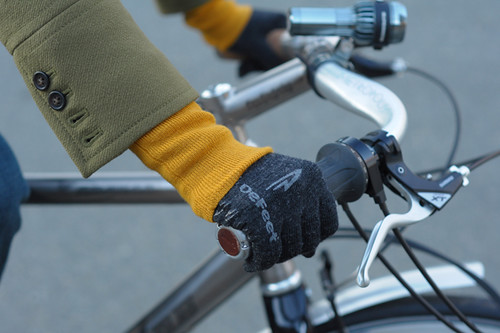 Even once I had the rest of my winter attirefigured out, the article of clothing that gave me the most trouble was gloves. I've probably gone through half a dozen pairs since I began cycling, and nothing worked quite the way I wanted it to. The big puffy gloves made it difficult to move my fingers and interferedwith shifting and braking, even if the design was supposedly cycling-specific. Also, I do photography work outdoors in the winter, and operating a camera with those is out of the question. Thermally-lined leather gloves can be just as warm while allowing for more mobility, but the leather gets stretched out and worn when used repeatedly on a bike. Wool gloves are hit and miss as far as warmth and some can be quite slippery on the handlebars. My salvation finally came in the form of these charcoal gray wool gloves by DeFeet which I bought on a whim at a local bike shop. They may not look like much, but I love them.
Even once I had the rest of my winter attirefigured out, the article of clothing that gave me the most trouble was gloves. I've probably gone through half a dozen pairs since I began cycling, and nothing worked quite the way I wanted it to. The big puffy gloves made it difficult to move my fingers and interferedwith shifting and braking, even if the design was supposedly cycling-specific. Also, I do photography work outdoors in the winter, and operating a camera with those is out of the question. Thermally-lined leather gloves can be just as warm while allowing for more mobility, but the leather gets stretched out and worn when used repeatedly on a bike. Wool gloves are hit and miss as far as warmth and some can be quite slippery on the handlebars. My salvation finally came in the form of these charcoal gray wool gloves by DeFeet which I bought on a whim at a local bike shop. They may not look like much, but I love them.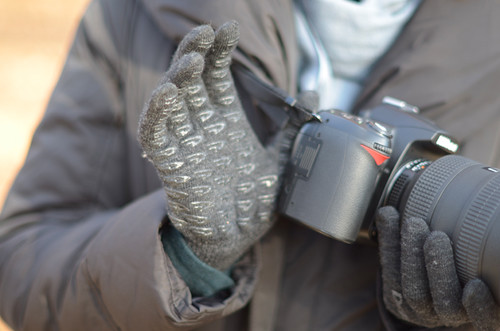 The DeFeet Duraglove is very densely knit, and warmer than any other thin wool gloves I've worn thus far. Once the temperature drops into the low 20s and I spend more than an hour outside I do begin to feel a chill in the finger tips, but above that they keep my hands perfectly warm (for comparison, I have a pair of stretchy-fleecy cross-country ski gloves rated for 20s temps that in reality give out in the low 30s). Aside from the warmth, the DeFeet gloves are form-fitting and stretchy, making it easy to operate both city bike and roadbike levers. And I can press all of my camera controls without removing them. They are not beautiful, but not horrendous looking either. They cost under $20. And the underside is covered with these silicone grippy things that ensure a firm hold on handlebars and camera equipment.
The DeFeet Duraglove is very densely knit, and warmer than any other thin wool gloves I've worn thus far. Once the temperature drops into the low 20s and I spend more than an hour outside I do begin to feel a chill in the finger tips, but above that they keep my hands perfectly warm (for comparison, I have a pair of stretchy-fleecy cross-country ski gloves rated for 20s temps that in reality give out in the low 30s). Aside from the warmth, the DeFeet gloves are form-fitting and stretchy, making it easy to operate both city bike and roadbike levers. And I can press all of my camera controls without removing them. They are not beautiful, but not horrendous looking either. They cost under $20. And the underside is covered with these silicone grippy things that ensure a firm hold on handlebars and camera equipment. The Co-Habitant is also pleased with his Ibex Knitty Gritty gloves that are similarly designed. He has a pair of both the full fingered and the fingerless versions and he uses both, depending on the temperature, for cycling and photography. The wool on these is softer and a bit chunkier than the wool of the DeFeet gloves, but the idea is the same: stretchy wool for ease of movement, with silicone grips on the underside for a firm hold. The grippy bits here are in the form of little Ibex logos, which I find very cute.
The Co-Habitant is also pleased with his Ibex Knitty Gritty gloves that are similarly designed. He has a pair of both the full fingered and the fingerless versions and he uses both, depending on the temperature, for cycling and photography. The wool on these is softer and a bit chunkier than the wool of the DeFeet gloves, but the idea is the same: stretchy wool for ease of movement, with silicone grips on the underside for a firm hold. The grippy bits here are in the form of little Ibex logos, which I find very cute.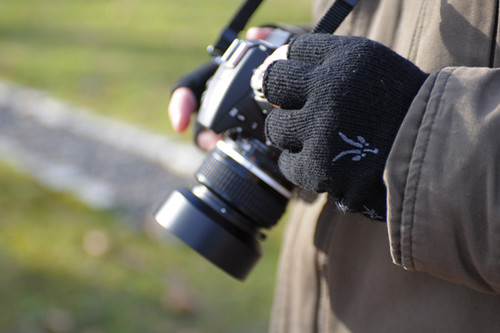 Unfortunately the Ibex Knitty-Gritty gloves do not work for me, because even the smallest size is too big for my hands (beware, these run large), so I cannot compare them to myDeFeetgloves directly.The prices are about the same. To my eye the Ibexgloves are more attractive, but of course this says nothing about performance. The cuff on the Ibex is a tad longer, but on both gloves the length is sufficient.The softer Ibex wool is nice, but I am suspicious that the looser knit might translate into less warmth. Also, I have noticed a bit of pilling on the Co-Habitant's full-fingered gloves after a season's use, whereas the wool on my DeFeet gloves seems less prone to this.
Unfortunately the Ibex Knitty-Gritty gloves do not work for me, because even the smallest size is too big for my hands (beware, these run large), so I cannot compare them to myDeFeetgloves directly.The prices are about the same. To my eye the Ibexgloves are more attractive, but of course this says nothing about performance. The cuff on the Ibex is a tad longer, but on both gloves the length is sufficient.The softer Ibex wool is nice, but I am suspicious that the looser knit might translate into less warmth. Also, I have noticed a bit of pilling on the Co-Habitant's full-fingered gloves after a season's use, whereas the wool on my DeFeet gloves seems less prone to this. Sadly, I did experience wear and tear with my DeFeet gloves: After 300+ miles of use on the bike, I wore a hole in the tip of the right index finger. While this is apparently a common problem to have with wool gloves, in my case I have to underscore that (1) I'd been wearing these on a roadbike and constantly pressing the ergo lever with my right hand, and (2) I have long fingernails, which no doubt contributed to this. Had I used them solely for transportation cycling on an upright bike, they probably would have been fine. In any case, I've now mended the hole (there is a special way to do this without destroying the articulated fingertip) and will see how long that lasts. If need be, I am willing to keep mending them and to buy a new pair every now and again, because as far as functionality and warmth go these gloves really work for me. I love the dense stretchy wool and the grippy underside; the versatility this style affords has made it my favourite winter cycling glove thus far.
Sadly, I did experience wear and tear with my DeFeet gloves: After 300+ miles of use on the bike, I wore a hole in the tip of the right index finger. While this is apparently a common problem to have with wool gloves, in my case I have to underscore that (1) I'd been wearing these on a roadbike and constantly pressing the ergo lever with my right hand, and (2) I have long fingernails, which no doubt contributed to this. Had I used them solely for transportation cycling on an upright bike, they probably would have been fine. In any case, I've now mended the hole (there is a special way to do this without destroying the articulated fingertip) and will see how long that lasts. If need be, I am willing to keep mending them and to buy a new pair every now and again, because as far as functionality and warmth go these gloves really work for me. I love the dense stretchy wool and the grippy underside; the versatility this style affords has made it my favourite winter cycling glove thus far.
 Death Valley from Dante's View, 5500 feet above the valley.
Death Valley from Dante's View, 5500 feet above the valley. The Golden Mountains. Those two little vertical “lines” in the middle of the picture are people!
The Golden Mountains. Those two little vertical “lines” in the middle of the picture are people! This is an area known as the Artist's Palette.
This is an area known as the Artist's Palette. At Zabriskie Point.
At Zabriskie Point. Zabriskie Point.
Zabriskie Point. The Devil's Golf Course. Telescope Peak, in the background, is the highest peak (over 11,000 feet) in the Panamint Range that borders Death Valley on the west.
The Devil's Golf Course. Telescope Peak, in the background, is the highest peak (over 11,000 feet) in the Panamint Range that borders Death Valley on the west. Close up view of the Devil's Golf Course. In 1934, it was determined that the salt and gravel beds of the Devil's Golf Course extend to a depth of more than 1,000 feet. Later studies suggest that in places the depth ranges up to 9,000 feet.
Close up view of the Devil's Golf Course. In 1934, it was determined that the salt and gravel beds of the Devil's Golf Course extend to a depth of more than 1,000 feet. Later studies suggest that in places the depth ranges up to 9,000 feet. The salt flats at Badwater, which is the lowest point in Death Valley at 232 feet below sea level. Walking on the salt flats was strange. It looked like concrete but there was some “give” in each step. In several spots there were muddy pools of water where small holes had been made in the salt flat.
The salt flats at Badwater, which is the lowest point in Death Valley at 232 feet below sea level. Walking on the salt flats was strange. It looked like concrete but there was some “give” in each step. In several spots there were muddy pools of water where small holes had been made in the salt flat.


 What is of most value to me about this picture though is the caption that was written on the back. "Uncle Henry and Aunt Lucy Robison my angle Mothers brother" - "Malissa" - and upside down "My uncle & aunt Henry & Lucy Robison"
What is of most value to me about this picture though is the caption that was written on the back. "Uncle Henry and Aunt Lucy Robison my angle Mothers brother" - "Malissa" - and upside down "My uncle & aunt Henry & Lucy Robison"  "Malissa" is Malissa Joslin Brubaker, my 2nd great grandmother, and this is the only "link" we currently have to the parents of her mother Lydia Robison who married Lysander Price Joslin.
"Malissa" is Malissa Joslin Brubaker, my 2nd great grandmother, and this is the only "link" we currently have to the parents of her mother Lydia Robison who married Lysander Price Joslin. Climbers strive to push the boundary of their sport to new limits every day – faster ascent times (
Climbers strive to push the boundary of their sport to new limits every day – faster ascent times ( According to Nordfors, other than the actual physical conditioning required to complete this sort of endurance event, the two most important aspects of his training was eating when your body didn’t want to, and staying focused and mentally alert while your body is completely exhausted. As a retired competitive bicycle racer, Nordsfors is not new to intense training and challenges. Although only a novice climber, Nordfors, 45, decided that after his retirement from racing a few years ago, he wanted to try new things and test the ability of his body to new limits. His trip from Puget Sound to Summit certainly proved to be a worthy challenge, and although Nordfors achieved both of his lofty goals, he is not completely satisfied with his bicycle ride from Tolmie Park to Paradise and will attempt to improve his time in a another epic tour. Best of luck on your next adventure Randall!
According to Nordfors, other than the actual physical conditioning required to complete this sort of endurance event, the two most important aspects of his training was eating when your body didn’t want to, and staying focused and mentally alert while your body is completely exhausted. As a retired competitive bicycle racer, Nordsfors is not new to intense training and challenges. Although only a novice climber, Nordfors, 45, decided that after his retirement from racing a few years ago, he wanted to try new things and test the ability of his body to new limits. His trip from Puget Sound to Summit certainly proved to be a worthy challenge, and although Nordfors achieved both of his lofty goals, he is not completely satisfied with his bicycle ride from Tolmie Park to Paradise and will attempt to improve his time in a another epic tour. Best of luck on your next adventure Randall!



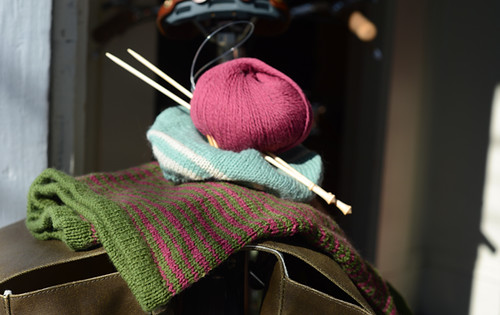
 The three oldest children of Charles and Elsie (Shuder) Wiseman: Perry Martin Comfort Wiseman (1906-1968), Leslie Wilson "Dick" Wiseman (1910-1978), and Eva Leah Wiseman (1908-1967).
The three oldest children of Charles and Elsie (Shuder) Wiseman: Perry Martin Comfort Wiseman (1906-1968), Leslie Wilson "Dick" Wiseman (1910-1978), and Eva Leah Wiseman (1908-1967).





 The DJ did an excellent job keeping the energy levels high, and even while taking photos I found myself moving and snapping to the beat.
The DJ did an excellent job keeping the energy levels high, and even while taking photos I found myself moving and snapping to the beat.












 It seemed like a sudden change, from the brightness of the sand dunes to the darkness of a forest of strangely twisted and misshapen Live Oak trees. The change was startling and it took a little while for your eyes to adjust. But once your eyes adjusted, what they beheld was really quite magical.
It seemed like a sudden change, from the brightness of the sand dunes to the darkness of a forest of strangely twisted and misshapen Live Oak trees. The change was startling and it took a little while for your eyes to adjust. But once your eyes adjusted, what they beheld was really quite magical.
 I followed the trail through the Live Oak forest on to the Sea Camp Ranger Station and Dock. There was very little wind and the water was as smooth as glass.
I followed the trail through the Live Oak forest on to the Sea Camp Ranger Station and Dock. There was very little wind and the water was as smooth as glass. It was getting late, close to 4 o'clock, so I followed the River Trail, where I was surrounded by tall, large Live Oak trees, back to the Dungeness Dock. Quite a difference between these trees and the ones at Sea Camp. As I was walking, I kept hearing something moving around in the underbrush. It took a few minutes but I finally saw what was making the noise.
It was getting late, close to 4 o'clock, so I followed the River Trail, where I was surrounded by tall, large Live Oak trees, back to the Dungeness Dock. Quite a difference between these trees and the ones at Sea Camp. As I was walking, I kept hearing something moving around in the underbrush. It took a few minutes but I finally saw what was making the noise. The most common view I had was from behind as I watched it for a short time. It scurried around with its nose hidden in the ground, searching for the next delicious morsel. But for a few brief seconds, the Armadillo stopped and stood on its hind legs.
The most common view I had was from behind as I watched it for a short time. It scurried around with its nose hidden in the ground, searching for the next delicious morsel. But for a few brief seconds, the Armadillo stopped and stood on its hind legs. With my arrival back at the Dungeness Dock, my visit to Cumberland Island was nearly over. The sun was starting to go down and it was getting colder. Along with several other passengers I patiently awaited the arrival of the ferry. This time I opted for the comfort of the warm cabin area. It was standing room only inside but sore feet and legs were a small price to pay for a little warmth. 'Twas much better than sitting outside where it was cold and windy!
With my arrival back at the Dungeness Dock, my visit to Cumberland Island was nearly over. The sun was starting to go down and it was getting colder. Along with several other passengers I patiently awaited the arrival of the ferry. This time I opted for the comfort of the warm cabin area. It was standing room only inside but sore feet and legs were a small price to pay for a little warmth. 'Twas much better than sitting outside where it was cold and windy!